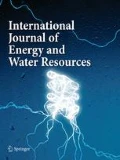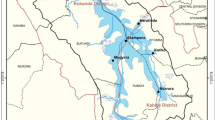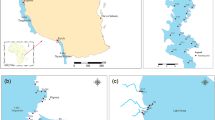Abstract
Nowadays, freshwater pollution is an environmental crisis caused mainly by anthropogenic activities. The water quality deterioration of Lake Beseka which is located in the Ethiopian portion of the East African Rift Valley is associated with rapid expansion of that lake that is not fully understood yet. This water quality impairment is the major cause of severe shortage of water supply for human consumption, irrigation use, and public health problems in that area. Hence, this study aimed to investigate the physicochemical and metal concentrations of Lake Beseka and evaluate the impact of the spatio-temporal variation on the water quality. Water samples were collected from six sampling sites during the dry and wet seasons. The concentration ranges for physicochemical parameters evaluated were: temperature (25–40 °C), electrical conductivity (EC) (1407–3321 μs/cm), turbidity (28.5–63.0 NTU), total dissolved solids (TDS) (740–1598 mg/L), pH (7.47–10.86), NO3−–N (0.30–16.69 mg/L), PO43−–P (0.03–13.00 mg/L), SO42− (10.00–70.00 mg/L), Cl− (0.00–200.00 mg/L), F− (0.40–3.80 mg/L), K (0.30–2.40 mg/L), Mg (0.40–2.46 mg/L), Ca (0.40–3.80 mg/L) and Fe (0.40–3.80 mg/L). For several parameters investigated, the result showed some significant differences (p < 0.05) among the six water samples during both the rainy and dry seasons, except for turbidity, EC, NO3−–N, PO43−–P, SO42− and Cl−. The values of many water quality parameters exceeded the WHO water quality guidelines for drinking water. Furthermore, the water is not suitable for irrigation due to extremely high values of pH (10) and other parameters dominating in salt lakes. This deteriorated water body has the potential to interfere with the natural function of the ecosystem by affecting human health in the area. Hence, to upgrade water quality to meet public health and environmental safety, implementation of suitable water treatment technologies is a crucial agenda to use Beseka lake water.





Similar content being viewed by others
References
Amalraj, Augustine, & Pius, Anitha. (2017). Removal of fluoride from drinking water using aluminum hydroxide coated activated carbon prepared from bark of Morinda tinctoria. Applied Water Science,7(6), 2653–2665.
Aminiyan, M. M., Aminiyan, F. M., & Heydariyan, A. (2016). Study on hydrochemical characterization and annual changes of surface water quality for agricultural and drinking purposes in semi-arid area. Sustainable Water Resources Management,2(4), 473–487.
Anon. 2017. “Awash Basin Water Quality.” (June).
APHA. (1998). Standard methods for the examination of water and wastewater. Washington: American Public Health Association; American Water Works Association; Water Environment Federation.
Belete, Mulugeta, Diekkrüger, Bernd, & Roehrig, Jackson. (2015). Characterization of water level variability of the main ethiopian Rift Valley Lakes. Hydrology,3(1), 1.
Bhateria, Rachna, & Jain, Disha. (2016). Water quality assessment of lake water: A review. Sustainable Water Resources Management,2(2), 161–173.
Damo, Robert, & Icka, Pirro. (2013). Evaluation of water quality index for drinking water. Polish Journal of Environmental Studies,22(4), 1045–1051.
De Paul Obade, V., Lal, R., & Chen, J. (2013). Remote sensing of soil and water quality in agroecosystems. Water, Air, and Soil Pollution,224(9), 1658.
Dehghani, M. H., Farhang, M., Afsharnia, M., & Mckay, G. (2018). Adsorptive removal of fluoride from water by activated carbon derived from CaCl2−Modified crocus sativus leaves: equilibrium adsorption isotherms, optimization, and influence of anions. Chemical Engineering Communications,205(7), 955–965.
Dinka, M. O. (2012). Analysing the extent (Size and Shape) of Lake Basaka expansion (main ethiopian Rift Valley) using remote sensing and GIS. Lakes and Reservoirs: Research and Management,17(2), 131–141.
Dinka, Megersa Olumana. (2016). Quality composition and irrigation suitability of various surface water and groundwater sources at Matahara plain. Water Resources,43(4), 677–689.
Dinka, M. O. (2017a). Analysis of standardized precipitation index (SPI) data for drought assessment. IOP Conference Series: Earth and Environmental Science,52(2), 1–7.
Dinka, M. O. (2017b). Delineating the drainage structure and sources of groundwater flux for Lake Basaka, Central Rift Valley region of Ethiopia. Water,9(12), 797.
Dinka, Megersa O., Loiskandl, Willibald, & Ndambuki, Julius M. (2014). Hydrologic modelling for Lake Basaka: Development and application of a conceptual water budget model. Environmental Monitoring and Assessment,186(9), 5363–5379.
Ewaid, Salam Hussein, & Abed, Salwan Ali. (2017). Water quality index for Al-Gharraf River, Southern Iraq. Egyptian Journal of Aquatic Research,43(2), 117–122.
Fito, Jemal, Bultossa, Geremew, & Kloos, Helmut. (2019a). Physicochemical and heavy metal constituents of the groundwater quality in Haramaya Woreda, Oromia Regional State, Ethiopia. International Journal of Energy and Water Resources,3(1), 23–32.
Fito, J., Tefera, N., Demeku, S., & Kloos, H. (2017). Water footprint as an emerging environmental tool for assessing sustainable water use of the bioethanol distillery at Metahara Sugarcane Farm, Oromiya Region, Ethiopia. Water Conservation Science and Engineering,2, 165–176.
Fito, Jemal, Tefera, Nurelegne, & Van Hulle, Stijn W. H. (2019b). Physicochemical properties of the sugar industry and ethanol distillery wastewater and their impact on the environment. Sugar Technology,21(2), 265–277.
Hailu EK (2014) Effect of blended irrigation water quality on soil physico-chemical properties and cotton yield in Middle Awash Basin. MSc. Thesis submitted to Hawassa University
Kebede, Elizabeth, Mariam, Zinabu G., & Ahlgren, Ingemar. (1994). The Ethiopian Rift Valley Lakes: Chemical characteristics of a salinity-alkalinity series. Hydrobiologia,288(1), 1–12.
Mititelu-Ionuș, O. (2016). Water quality index -assessment method of the Motru River water quality (Oltenia, Romania).
Mulugeta, E., Zewge, F., Johnson, C.A., & Chandravanshi, B.S. (2015). Aluminium hydro (oxide )– based (AO) adsorbent for defluoridation of drinking water: optimisation, performance comparison, and field testing. Water SA, 41, 121–128.
Nigussie, W., Zewge, F., & Chandravanshi, B.S. (2007). Removal of excess fluoride from water using residue from alum manufacturing process. Journal of Hazardous Materials, 147, 954–963. https://doi.org/10.1016/j.jhazmat.2007.01.126.
Olumana, M., Loiskandl, W., Fürst, J., & Shaw, R. (2009a). Effect of Lake Basaka Expansion on the Sustainability of Matahara SE in the Awash River Basin, Ethiopia. In: 34th WEDC International Conference, United Nations Conference Centre, Addis Ababa, Ethiopia (1993):1–9
Olumana, M., W. Loiskandl, J. Fürst, and R. Shaw. (2009b). Effect of Lake Basaka Expansion on the Sustainability of Matahara SE in the Awash River Basin, Ethiopia. In: 34th WEDC International Conference, United Nations Conference Centre, Addis Ababa, Ethiopia 1–9.
Palamuleni, Lobina, & Akoth, Mercy. (2015). Physico-chemical and microbial analysis of selected borehole water in Mahikeng, South Africa. International Journal of Environmental Research and Public Health,12, 8619–8630.
Poddar, P. K., & Sahu, O. (2017). Quality and management of wastewater in sugar industry. Applied Water Science,7(1), 461–468.
Reimann, Clemens, Bjorvatn, Kjell, Frengstad, Bjørn, Melaku, Zenebe, Tekle-Haimanot, Redda, & Siewers, Ulrich. (2003). Drinking water quality in the Ethiopian Section of the East African Rift Valley I—data and health aspects. Science of the Total Environment,311(1–3), 65–80.
Sewanu, I., Isaac, A., Balogun, I., Okanlawon, A.S. (2018). Integrated approaches to groundwater quality assessment and hydrochemical processes in Lagos, Nigeria. Applied Water Science, 8, 1–19. https://doi.org/10.1007/s13201-018-0847-y.
Sharifinia, M., Ramezanpour, Z., & Imanpour, J., et al. (2013). Water quality assessment of the Zarivar Lake using physico-chemical parameters and NSF-WQI indicator, Kurdistan Province-Iran. International journal of Advanced Biological and Biomedical Research, 1, 302–312.
Singh, S. K., Delhi, New, & Delhi, New. (2015). Water quality index assessment of Bhalswa Lake, New Delhi. International Journal of Advanced Research,3(5), 1052–1059.
Sivaranjani, S., Rakshit, Amitava, & Singh, Samrath. (2015). Water quality assessment with water quality indices. International Journal of Bioresource Science,2(2), 85.
Tekle-Haimanot, R., Melaku, Z., Kloos, H., Reimann, C., Fantaye, W., Zerihun, L., & Bjorvatn, K. (2006). The geographic distribution of fluoride in surface and groundwater in Ethiopia with an emphasis on the Rift Valley. Science of The Total Environment, 367, 182–190. https://doi.org/10.1016/j.scitotenv.2005.11.003.
Umerfaruq, M.Q. (2015). Physico-chemical parameters of water in Bibi Lake, Ahmedabad, Gujarat, India. Pollut Eff Control, 3, 1–5. https://doi.org/10.4172/2375-4397.1000134.
UN Water. 2018. Nature-based solutions for water, the united nations world water development report 2018 report.
UN-Water. (2003). Water for people water for life. The united nations world water development report 36.
UN-Water. 2015. Water for a sustainable world, the united nations world water development report 2015 report WATER. Paris.
WHO. 2017. Guidelines for drinking water quality.
Zhang, Chunlong. (2007). Fundamentals of environmental sampling and analysis. Hoboken: Wiley.
Acknowledgements
We would like to thank Addis Ababa University for supervising the financial support given by the Ministry of Education of Ethiopia.
Funding
Addis Ababa University supervised the fund support offered by the Ministry of Education in Ethiopia.
Author information
Authors and Affiliations
Contributions
AU contributed to data collection, experimental design, laboratory experiment, statistical analysis and manuscript writing while BA and JF mainly contributed for experimental design, statistical analysis, manuscript writing and editing.
Corresponding author
Ethics declarations
Conflict of interest
The authors have declared that they have no conflict of interests.
Availability of data and materials
All data are fully available without restriction.
Consent for publication
Not applicable.
Ethics approval and consent to participate.
Not applicable
Rights and permissions
About this article
Cite this article
Umer, A., Assefa, B. & Fito, J. Spatial and seasonal variation of lake water quality: Beseka in the Rift Valley of Oromia region, Ethiopia. Int J Energ Water Res 4, 47–54 (2020). https://doi.org/10.1007/s42108-019-00050-8
Received:
Accepted:
Published:
Issue Date:
DOI: https://doi.org/10.1007/s42108-019-00050-8




